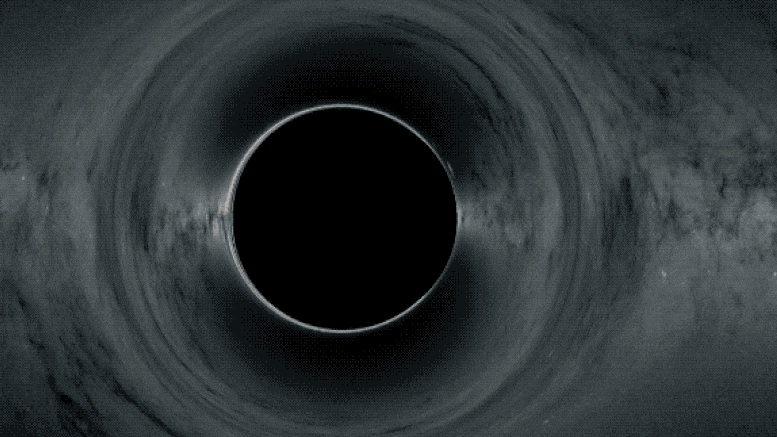
Black holes distort a starry background, capture light, and produce black hole silhouettes in this simulation. Each has a mass about 500,0000 times the Sun’s and a distinctive feature called a photon ring outlining the black hole. Credit: NASA’s Goddard Space Flight Center; background, ESA/Gaia/DPAC
Our universe is a chaotic sea of ripples in space-time called gravitational waves. Astronomers think waves from orbiting pairs of supermassive black holes in distant galaxies are light-years long and have been trying to observe them for decades, and now they’re one step closer thanks to NASA’s Fermi Gamma-ray Space Telescope.
Fermi detects gamma rays, the highest-energy form of light. An international team of scientists examined over a decade of Fermi data collected from pulsars, rapidly rotating cores of stars that exploded as supernovae. They looked for slight variations in the arrival time of gamma rays from these pulsars, changes which could have been caused by the light passing through gravitational waves on the way to Earth. But they didn’t find any.
While no waves were detected, the analysis shows that, with more observations, these waves may be within Fermi’s reach.
“We kind of surprised ourselves when we discovered Fermi could help us hunt for long gravitational waves,” said Matthew Kerr, a research physicist at the U.S. Naval Research Laboratory in Washington. “It’s new to the fray – radio studies have been doing similar searches for years. But Fermi and gamma rays have some special characteristics that together make them a very powerful tool in this investigation.”
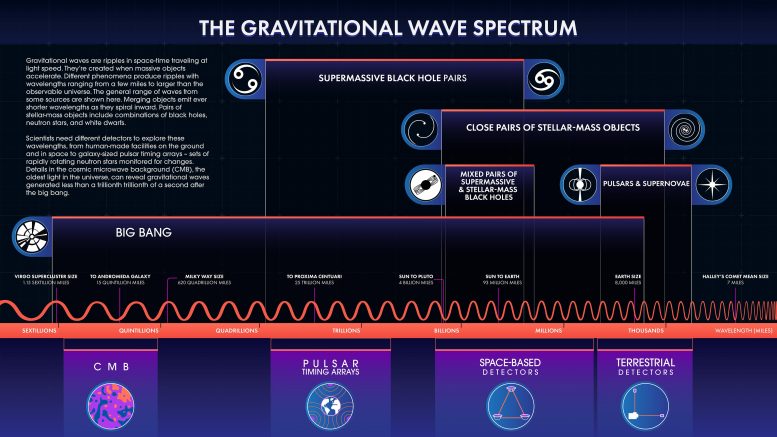
The length of a gravitational wave, or ripple in space-time, depends on its source, as shown in this infographic. Scientists need different kinds of detectors to study as much of the spectrum as possible. Credit: NASA’s Goddard Space Flight Center Conceptual Image Lab
The results of the study, co-led by Kerr and Aditya Parthasarathy, a researcher at the Max Planck Institute for Radio Astronomy in Bonn, Germany, were published online by the journal Science on April 7.
When massive objects accelerate, they produce gravitational waves traveling at light speed. The ground-based Laser Interferometer Gravitational Wave Observatory – which first detected gravitational waves in 2015 – can sense ripples tens to hundreds of miles long from crest to crest, which roll past Earth in just fractions of a second. The upcoming space-based Laser Interferometer Space Antenna will pick up waves millions to billions of miles long.
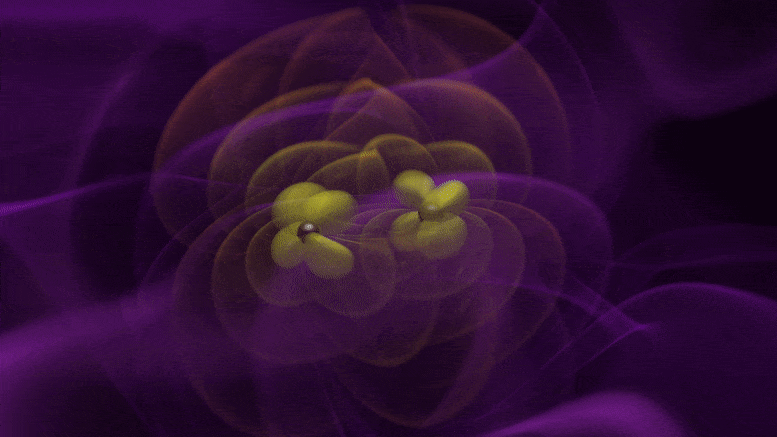
This visualization shows gravitational waves emitted by two black holes of nearly equal mass as they spiral around each other. Orange ripples represent distortions of space-time caused by the rapidly orbiting masses. These distortions spread out and weaken, ultimately becoming gravitational waves (purple). This simulation was performed on the Pleiades supercomputer at NASA’s Ames Research Center. Credit: NASA/Bernard J. Kelly (Goddard and Univ. of Maryland Baltimore County), Chris Henze (Ames) and Tim Sandstrom (CSC Government Solutions LLC)
Kerr and his team are searching for waves that are light-years, or trillions of miles, long and take years to pass Earth. These long ripples are part of the gravitational wave background, a random sea of waves generated in part by pairs of supermassive black holes in the centers of merged galaxies across the universe.
To find them, scientists need galaxy-sized detectors called pulsar timing arrays. These arrays use specific sets of millisecond pulsars, which rotate as fast as blender blades. Millisecond pulsars sweep beams of radiation, from radio to gamma rays, past our line of sight, appearing to pulse with incredible regularity – like cosmic clocks.
As long gravitational waves pass between one of these pulsars and Earth, they delay or advance the light arrival time by billionths of a second. By looking for a specific pattern of pulse variations among pulsars of an array, scientists expect they can reveal gravitational waves rolling past them.
This visualization shows gravitational waves emitted by two black holes (black spheres) of nearly equal mass as they spiral together and merge. Yellow structures near the black holes illustrate the strong curvature of space-time in the region. Orange ripples represent distortions of space-time caused by the rapidly orbiting masses. These distortions spread out and weaken, ultimately becoming gravitational waves (purple). The merger timescale depends on the masses of the black holes. For a system containing black holes with about 30 times the sun’s mass, similar to the one detected by LIGO in 2015, the orbital period at the start of the movie is just 65 milliseconds, with the black holes moving at about 15 percent the speed of light. Space-time distortions radiate away orbital energy and cause the binary to contract quickly. As the two black holes near each other, they merge into a single black hole that settles into its “ringdown” phase, where the final gravitational waves are emitted. For the 2015 LIGO detection, these events played out in little more than a quarter of a second. This simulation was performed on the Pleiades supercomputer at NASA’s Ames Research Center. Credit: NASA/Bernard J. Kelly (Goddard and Univ. of Maryland Baltimore County), Chris Henze (Ames) and Tim Sandstrom (CSC Government Solutions LLC)
Radio astronomers have been using pulsar timing arrays for decades, and their observations are the most sensitive to these gravitational waves. But interstellar effects complicate the analysis of radio data. Space is speckled with stray electrons. Across light-years, their effects combine to bend the trajectory of radio waves. This alters the arrival times of pulses at different frequencies. Gamma rays don’t suffer from these complications, providing both a complementary probe and an independent confirmation of the radio results.
“The Fermi results are already 30% as good as the radio pulsar timing arrays when it comes to potentially detecting the gravitational wave background,” Parthasarathy said. “With another five years of pulsar data collection and analysis, it’ll be equally capable with the added bonus of not having to worry about all those stray electrons.”
Within the next decade, both radio and gamma-ray astronomers expect to reach sensitivities that will allow them to pick up gravitational waves from orbiting pairs of monster black holes.
“Fermi’s unprecedented ability to precisely time the arrival of gamma rays and its wide field of view make this measurement possible,” said Judith Racusin, Fermi deputy project scientist at NASA’s Goddard Space Flight Center in Greenbelt, Maryland. “Since it launched, the mission has consistently surprised us with new information about the gamma-ray sky. We’re all looking forward to the next amazing discovery.”
Reference: “A gamma-ray pulsar timing array constrains the nanohertz gravitational wave background” by The Fermi-LAT Collaboration, 7 April 2022, Science.
DOI: 10.1126/science.abm3231
The Fermi Gamma-ray Space Telescope is an astrophysics and particle physics partnership managed by Goddard. Fermi was developed in collaboration with the U.S. Department of Energy, with important contributions from academic institutions and partners in France, Germany, Italy, Japan, Sweden, and the United States.

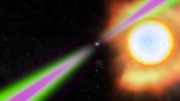

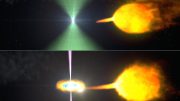
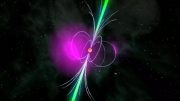
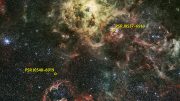
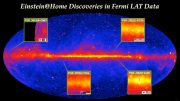
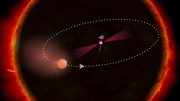
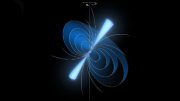
I’m well aware scientists believe time dilation and gravity waves from rotating black stars have been established. Both claims are incorrect. Although scientists have clearly established clocks on board the space station in orbit of the Earth run slower than their Earth counterpart, and that clocks on board GPS satellites run faster, clocks running slower on board the manned space station do so due to zero gravity. Clocks on board GPS satellites run faster because of the GPS satellite’s orbital location inside the Van Allen radiation belt.
As to gravity waves presumed due to black holes, black holes don’t exist. If scientists are detecting gravity waves, it likely what scientists are detecting is rogue gravity waves, similar to rogue waves in the Earth’s oceans.
Why don’t black holes exist?
… hmh, the geometry and speed of the geometry,,, or something like that!